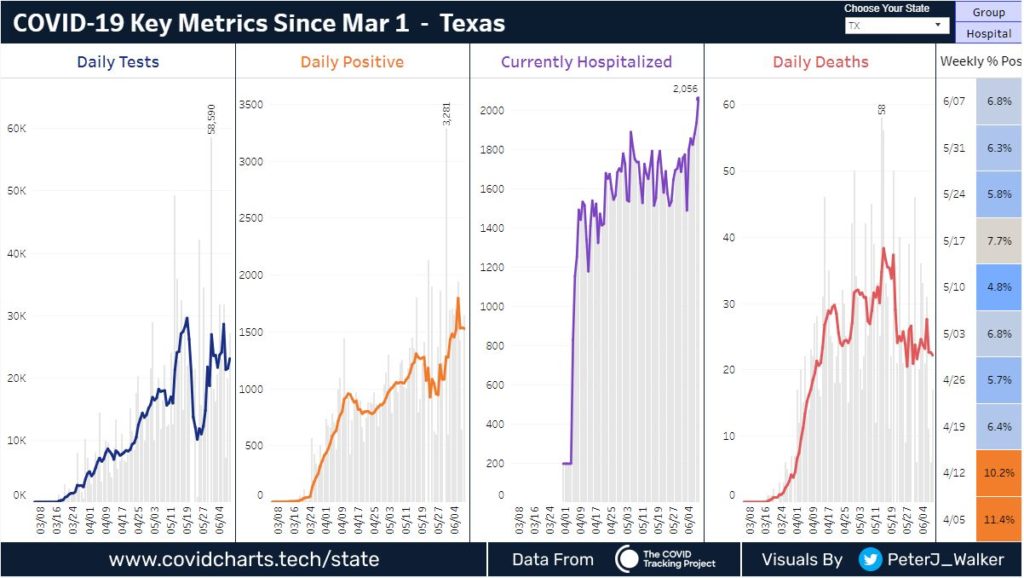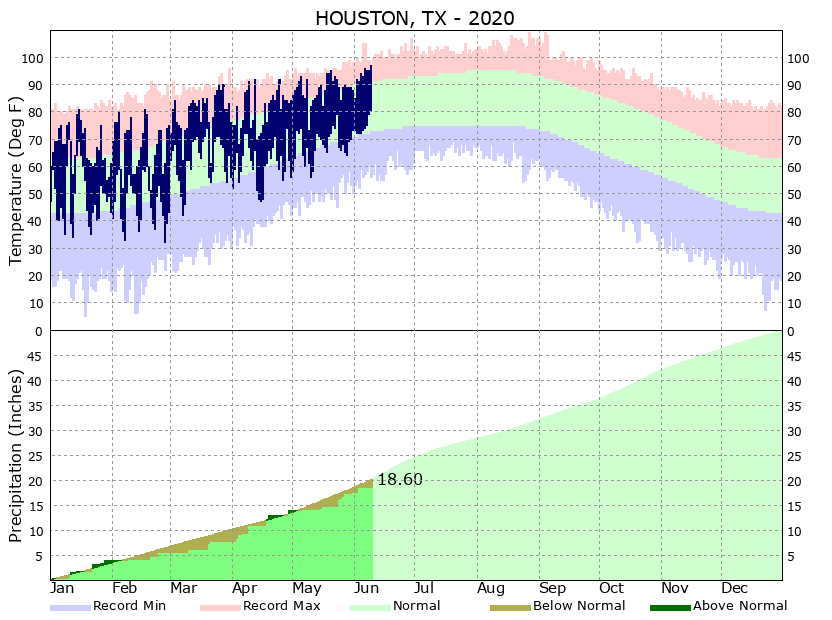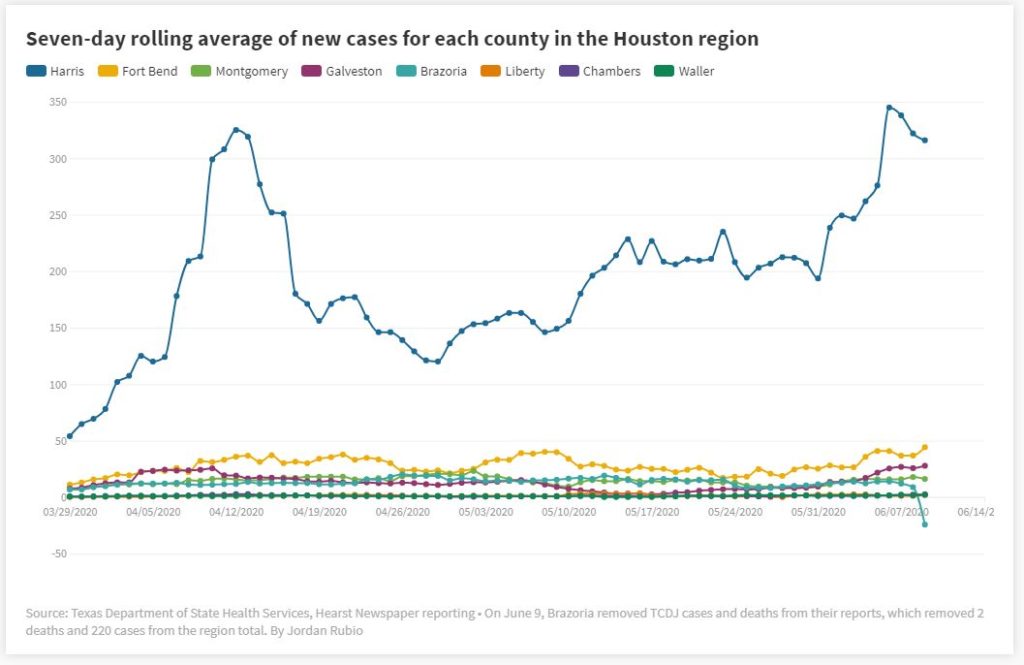Nearly three months have passed since we first addressed COVID-19 and the then-unknown effect of weather on its spread in warmer climates. Since that time we have learned some things, and have three months of data to draw upon in Texas. From this we can conclude that although weather may have some modest effect, it is not likely to have a significant dampening effect on the transmission of the disease.
COVID-19 and Texas
We’ll start this post by looking at the spread of COVID-19 in Texas. I encourage you to visit this site, put together by Peter James Walker, which provides amazing visualizations of coronavirus data (from the Texas Department of State Health Services) with regard to testing, positive cases, deaths, and hospitalizations. This allows us to understand trends in the data.

Here we can see that cases are more or less increasing in line with more testing across the state. However, after initially dropping, the share of positive tests seems to be increasing, up to 7 percent from 5 percent about one month ago. So far, at least, deaths have not caught up to cases. This may be due to better care, or some other factors. It’s just hard to know.
What concerns us is that hospitalizations have reached a record high in Texas for COVID-19. You may have questions about the test data, or false positives, but hospitalizations for COVID-19 are measurement that is difficult to fudge. The trend is upward, and real. We are still a ways away from reaching hospital and ICU capacity in Houston or across the state, but the concern is where does the trend go from here? I don’t think anyone can say.
Weather and COVID-19
What we can say is that this spike in hospitalizations (and thus, severe cases) due to the virus is occurring at the very moment when summer heat is beginning to descend on Texas. The state’s average temperature in June reaches 90 degrees. Much of the state is humid most of the time in summer. And still, the disease is spreading. In fact, based upon the hospitalization data, it seems clear that COVID-19 is more widespread now in Texas than at any time before. The disease is spiking even harder in other, similarly warm states, such as Arizona.

This supports the emerging science viewpoint on weather and COVID 19, that summer heat will not be much of a factor in slowing its initial spread through the human population.

The public health messaging from the World Health Organization and the U.S. government amidst this pandemic has not been consistent or particularly good. However, the data are telling us that COVID-19 is still spreading in Texas despite the heat. It may become even more widespread this summer as we (understandably) seek to return to a business-as-normal posture. What seems prudent is the continued wearing of masks in locations where social distancing is not possible. When you wear a mask it may be uncomfortable, you may think it makes you look funny. But you’re also telling the person next to you that you value them, and want to do your part to prevent spreading COVID-19 too far.
Sponsor Note from Reliant
To support our neighbors across Texas, Reliant has committed $765,000, including $440,000 to the Greater Houston area, for local community relief funds, initiatives to protect frontline workers and those adversely impacted by COVID-19, and treatment/prevention solutions. The donations are part of our community program, Reliant Gives, to provide support across the state of Texas and our parent company, NRG Energy, Inc.’s $2 million donation to pandemic relief efforts. Learn more about our commitment and customer support resources here. Now more than ever, we’re working to light the way and keep Texans powered and connected to one another.
It’s unfortunate that COVID19 has become politicized, but it’s a very real and very present public health emergency. Space City Weather is a facts-based site that believes in evidence-based reporting, not dogma. We’ll be removing any comments that imply the current crisis is imaginary, or that hospitals are lying about COVID19 rates to get more medicare dollars, or any of the other disproven conspiracy theory talking points from unreliable fringe sites.
Thank you. As someone who works at a grocery store and doesn’t have a choice to stay home or not if I want to survive and pay my bills, when someone comes at me without a mask, I’m not inclined to think that person has my best interest at heart. I’d like to be able to see my family without overt worry that I’m going to take the disease home to them, and I’d like to think the people that call us “heroes,” actually mean it.
One thing to keep in mind is it is usually about twelve days or so between an exposure and hospitalization. What we are seeing now is the effects of all the stupid behavior people were engaging in over Memorial Day weekend (and it’s why we are seeing so many positives in the 20-40 age group). In the next 7-10 days we will start seeing the effects of 60,000 people gathering downtown without social distancing or even wearing masks in many cases.
It ain’t over, people.
What do you think about the idea that it is “inside weather” that causes numbers to rise? In the northeast, the weather has now improved to the point where people can engage in more outside activities. In Houston (and presumably Arizona), the heat is now driving more people to inside activities.
Yep, just what I was going to say. A few weeks ago there was someone (I think on NPR) saying the data indicated 80% of the infections occur indoors. So as heat goes up here, people go indoors. The exact opposite of what happens in the great white north.
The pattern that has typically come with seasonal flu/colds abating in summer is really about more people engaging in outdoor activities, and maybe a bit to do with extra UV from the sun applied to those going outside, and less to do with the heat itself, I think. Weather-based heat isn’t enough to denature a viral particle, after all.
Here in Texas, in summer (and all year at most offices) we’re all huddled inside in the air conditioning that circulates our air and recirculates the virus particles throughout enclosed areas. wince Alas, AC is very much necessary down here, unless we also want to add heatstroke to our problems. Which. . . no. I don’t want to add that, thank you.
“When you wear a mask it may be uncomfortable, you may think it makes you look funny. But you’re also telling the person next to you that you value them”
Thank you for this!!
I agree…thank you for reminding people that we are indeed looking out for each other when we wear a mask.
I like the line “If you don’t like wearing a mask, you’ll hate wearing a ventilator”.
Think of a mask as a fashion statement opportunity, as well as a way to protect others. I just got a batch of plain white ones that I will tie dye for fun!
Great article! So appreciate your insights!
Please quit using Twitter links in your articles. I avoid Twitter at all costs. THX
“So you’re saying there’s a chance?”
One of my many favorite movie lines….
Thank you for your informative, fact based post. I sincerely appreciate your reminder about why we wear masks. Let’s all do our part to care for one another.
Do you think re-opening & lifting shut-down has affected the numbers, to obscure impact of higher temps?